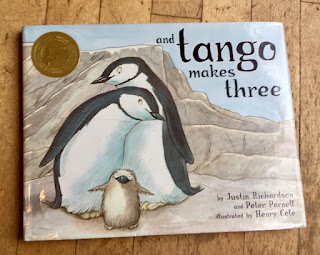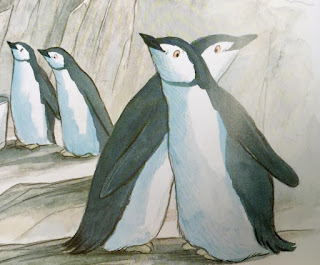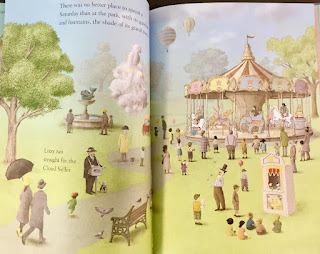(Nancy Paulsen Books, 2020)
Written by Derrick D. Barnes
Illustrated by Gordon C. James
Goosebumps. A laugh. A smile, followed by repeated nodding. Several moans, the equivalent to saying, “Amen.”
That’s a summary of my visceral response to a read-through of I Am Every Good Thing. It’s truly a good thing. It’s a book every Black boy needs to experience, time and again. If it made me feel affirmed, if it reminded me of The Cup Half Full, I can only imagine the power it has on Black boys and Black men.
I came upon this book after reading a CNN news story last week about an Alabama school district rescinding its invitation for author Derrick Barnes to visit three of its schools due to “contract issues and a parent’s ‘concern’ regarding Barnes’ social media posts.” A close read seems to indicate that the “contract issues” are a red herring, part payment already having been made for the author’s appearances. This is what a district PR machine must add on to distract from censorship and the anti-woke version of cancel culture.
More on the controversy, below, but first let me highlight the content of this extraordinary book which exudes empowerment. The book opens with a Black boy of four or five, flying through the air in red Converse shoes and a richly colored cap, his smile bright, his eyes looking back as a child so often does in a “Watch me, Daddy” moment. It’s the first of an entire gallery of gorgeous oil-painted illustrations by Gordon C. James. The text:
I amA nonstop ball of energy.
Powerful and full of light.
I am a go-getter. A difference maker.
A leader.
Yes! Everything is affirming, a variation on the title, I am every good thing. This is what we want children to believe about themselves.
The book proceeds to show Black boys of various ages playing in the snow, looking through a microscope, splashing about in mask and snorkel, listening intently to something on headphones, standing in the forest. There’s a two-page spread of a Black boy skateboarding and I couldn’t help but think of Tyre Nichols.
There’s a page of amusing, cocky bravado, the text reading:
I am a grand slam, bases fully loaded.
I’m a nasty two-handed dunk,
holding on to the rim,
just to remind you that
I’m still the man.
Believe that.
The illustration shows a laughing boy being raised to the basketball net by an equally gleeful father figure.
Every page has nuggets of text that oozing pride and personality. Lines like, “I am a sponge, soaking up information, knowledge, and wisdom. I want it all, and I am alllllll ears” are destined to makes readers, young and old, grin. This is as delicious as anyone’s favorite home-cooked meal.
Barnes understands the weight on Black male shoulders and doesn’t shy away from more serious messaging as in the following text:
Although I am something like a superhero,
every now and then,
I am afraid.
I am not what they might call me,
and I will not answer to any name
that is not my own.
I am what I say I am.
I could go on. This is the kind of book where I want to highlight every passage. (I ADORE the page that references paper airplanes!)
 |
Photo on Barnes' Instagram,
November 8, 2022 |
So what caused a single parent’s concern, leading to the cancelation of the author visit? The vague “social media” issue is problematic. What does the writer take from this? What do students, staff and parents in the district take from it? Free speech is of great value but, given that Barnes was presumably visiting elementary schools, not all speech is suited to a setting with younger learners. It’s possible there were things to consider, but nothing specific has been raised. It feels like Barnes and his work have been tainted by an unspecified social media post or posts. That’s deeply concerning to me.
As a former school principal, I listened to many parents express concerns over curriculum, presentations, teaching styles, disciplinary decisions, food served at events and student interactions off school grounds beyond school hours. Parents have a strong, valid interest in their child(ren)’s learning. Sometimes a discussion helps find common ground. Rarely do things end with agreeing to disagree. On a few occasions, however, I have honored a parent’s request for their child to opt out of a lesson or school event. It would take some extremely troubling social media posts to all-out cancel a speaker. What did Barnes do?
I searched Twitter, where people tend to rant, and it appears Derrick Barnes does not have an account. I found his author website and his only social media presence appears to be on Instagram (@authorderrickdbarnes) so I scrolled through his 120 posts from the past twelve months. (Is a third grader going to scroll beyond that? What would motivate a parent to search further?) Zero concerns.
Most posts promoted his books. There were several touching posts about his love for his family and how proud he is of how his sons are growing up. His posts are written with the same positivity as Every Good Thing. There’s a post from May 12, 2022, celebrating his twenty-first anniversary. The words written about his marriage and his wife are beautiful. May we all feel this way in long-term relationships! There’s an October 24th post about his weekly practice of leaving voice messages to each of his four sons to fill them up with positivity and a genuine belief in them. Amazing! If anything, I was tempted to follow him, something I don’t do much of when it comes to people I don’t know personally.
I’m going to take a darker view of things and, yes, consider the author’s cancelation as being based in racism, however it may otherwise be cloaked. This kind of conjectur
e is what comes up when a school district fails to adequately explain its actions. Barnes’ books and characters focus on Black people. He’s Black; he’s writing what he knows. The district he was supposed to visit is in Hoover, Alabama, a rapidly growing suburb of Birmingham. According to Wikipedia and the 2020 Census, 92,000 live in Hoover—68% white, 17% Black. Birmingham, a city with declining population, has 201,000 residents—23% white, 68% Black. As in so many places in America, the races remain geographically divided due to a multitude of reasons but, for many, choice is a factor. Hoover is “comfortably” white and a scheduled visit by a Black author may have been uncomfortable, at least to one parent.

Speculation, of course. Nothing else to go on.
The truly unfortunate result is that several classes of young learners were denied the opportunity to have an author visit. They didn’t get to hear Derrick Barnes read one of his picture books like I Am Every Good Thing, The King of Kindergarten or Crown: An Ode to the Fresh Cut.
Speaking of school visits, Barnes says in the CNN article, “You see in their [Black children’s] eyes how much it means to them. When they meet me, a Black man, an author, and see I’m not an entertainer, an athlete, or a rapper. They see what else they can be besides the stereotypes that are starting to seep into their psyche.” Barnes also noted the importance of his visits and books to non-Black students:
It’s even more important for White children to see Black,
Brown, Asian, Muslim characters. If they don’t see those
kids in their immediate environments, these books serve
to counter stereotypes they’re taught. They get to learn
about different cultures while also seeing the similarities,
how we live, how we dream, the things we all fear, the
things that bring us joy. But they won’t realize this if
they only see themselves.
I can only hope the publicity from the cancelation of the school visits will lead more readers, young and old, Black and non-Black, to the books of Derrick Barnes.































